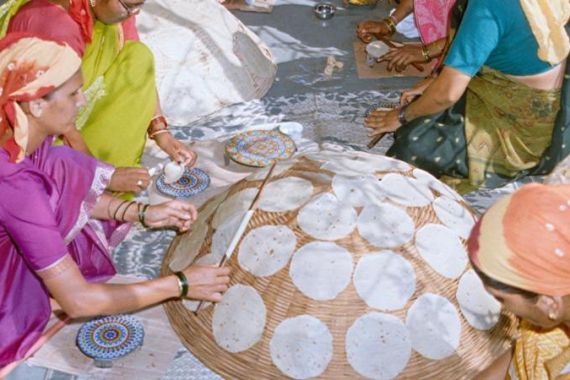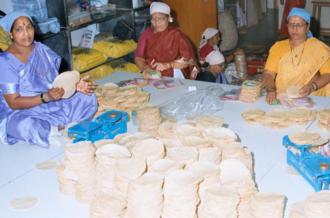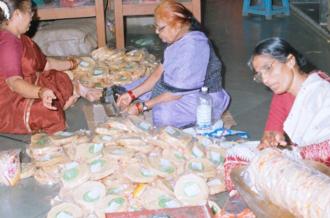From $1 to $200m: An Indian success story
Indian cooperative selling papad grows into hugely successful brand, decades after having very modest start.

Mumbai, India – Poor and with little education, seven housewives from Lohana Niwas, an old residential building in Mumbai’s Girgaum area, came together in1959 with a borrowed capital of Rs 80 or $1.50 to start a business of making papads, a crispy bread made from flour and spices.
In largely patriarchal India, few took note of the women whose future looked as bleak as their immediate surrounding.
But that was then. Now, five decades later, they are remembered as trailblazers – whose recipe for the traditional snack also turned out to be a great business success.
Today, their venture known as Shri Mahila Griha Udyog Lijjat Papad is India’s largest selling papad brand, with more than $200 million in sales, and employs more than 43,000 women across the country.
Business model
Founded on the Gandhian principle of Sarvodaya or progress for all, Lijjat Papad is often described as a symbol of women’s empowerment in India.
Just like its early days, most of Lijjat’s current workforce continues to come from the poorest sections of India’s society for whom a life of dignity would otherwise seem difficult.
On its part, Lijjat readily embraces anyone who wants to be a part of the family.
“Any woman who wants to roll papad can approach any of our branches and become a member,” Swati Paradhkar, president of the cooperative, told Al Jazeera.
Once inducted, a member is paid Rs 30 to roll 1kg of dough into papads.
 |
| Papad is a crispy bread made from flour and spices [Deborshi Chaki/ Al Jazeera] |
“There is no upper limit to how much a member can roll and sometimes members also get their other family members to work with them,” Paradhkar says.
On joining, a member signs a pledge form, which serves as her formal entry, and thereafter she is considered a sister-member, where she can work six days a week and gets paid on a daily basis for the quantity rolled.
The policy of “no refusal” to new members may seem to go against traditional business sense, but surprisingly enough Lijjat Papad has never faced any difficulty in giving work to new members.
Each branch of Lijjat Papad is run in a decentralised manner and is headed by a sanchalika or branch head who is chosen by consensus.
Apart from production, the branch is also responsible for marketing its products in the area allotted to it.
To maintain quality standards of Lijjat products and uniformity in taste, the central office supplies the raw material – mung and urad flour — to all its branches.
This remains the only involvement of the central office in the entire production and marketing exercise of the branch office.
However, in case of surplus production, the excess stock is acquired by the central office and dispatched to other markets.
Level playing field
One of the most significant aspects of Lijjat success story is how it treats its members. Ever since its existence, Lijjat has followed the policy of electing its highest office bearers from the lowest ranks.
“Equality for all its members irrespective of their financial and social position has been one of foremost guiding principles of Lijjat Papad, which has helped it transform lives of women for several decades now,” says Sharda D Kubal, who joined the organisation 20 years ago as a papad roller and eventually rose to become a Secretary in Lijjat Papad’s managing committee, its topmost decision-making body.
However, the top office bearers are in no way superior to sister-members, and are therefore expected to behave accordingly.
In her late 40s now, Paradhkar has been rolling papads from the age of ten.
“I come from a very poor family but with my earnings I have managed to educate my two sons, both of whom are working in the United States,” she says. “While members can climb the organisational ladder from there but it’s imperative that everyone starts from the bottom.”
The same principle is also applied when it comes to sharing profits, as Lijjat essentially remains a non-profit organisation.
Of its entire turnover, Lijjat Papad sets aside only 2% of profits for organisational expenditure and distributes the rest among its members thrice a year.
Lijjat also does not accept donations.
“We are a business enterprise and very successful at that,” Paradhkar says.
But how does Lijjat remain so profitable even after so many years, especially in the face of stiff competition by large FMCG companies and multinationals?
 |
| In case of surplus production, the excess stock is acquired by the central office [Deborshi Chaki/ Al Jazeera] |
“People often ask how we manage to do well without professional managers,” says Pratibha Sawant, Lijjat’s elderly vice president, who has been a papad roller since 1973 and is now in her late 60s.
“We just focus on the quality of the product and value relationships,” she says. “We get papads for testing from all centres everyday and if we find any deviation from our quality, for example, if the salt is less or more we immediately intimate that particular centre to destroy the entire lot, even if it amounts to a million rupees worth of production.”
Similarly, utmost care is taken to maintain the quality of ingredients, for instance urad dal is imported from Myanmar, asafoetida is imported from Iran and black pepper comes from Kerala in South India.
Over the years, Lijjat has also ventured into other product categories that include spices, detergents and homemade snacks, which have met varying degree of success.
At the same time, Lijjat has also expanded into the overseas market and exports a quarter of its production to the Middle East, Europe and the US.
However, when asked about Lijjat biggest achievement till date, Sawant sums it up: “More than the revenues and profits I feel it’s the sense of self assurance and hope that Lijjat has instilled among its members which counts the most.”
And most would agree.
This feature is a part of our ongoing special India coverage. To read more stories click here.